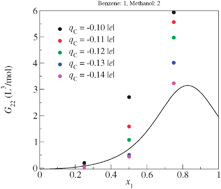A Kirkwood–Buff force field for the aromatic amino acids
Abstract
In a continuation of our efforts to develop a united atom non-polarizable

* Corresponding authors
a
Department of Chemistry, 213 CBC Building, Kansas State University, Manhattan, USA
E-mail:
pesmith@ksu.edu
Fax: 785-532-6666
Tel: 785-532-5109
In a continuation of our efforts to develop a united atom non-polarizable

 Please wait while we load your content...
Something went wrong. Try again?
Please wait while we load your content...
Something went wrong. Try again?
E. A. Ploetz and P. E. Smith, Phys. Chem. Chem. Phys., 2011, 13, 18154 DOI: 10.1039/C1CP21883B
To request permission to reproduce material from this article, please go to the Copyright Clearance Center request page.
If you are an author contributing to an RSC publication, you do not need to request permission provided correct acknowledgement is given.
If you are the author of this article, you do not need to request permission to reproduce figures and diagrams provided correct acknowledgement is given. If you want to reproduce the whole article in a third-party publication (excluding your thesis/dissertation for which permission is not required) please go to the Copyright Clearance Center request page.
Read more about how to correctly acknowledge RSC content.
 Fetching data from CrossRef.
Fetching data from CrossRef.
This may take some time to load.
Loading related content
